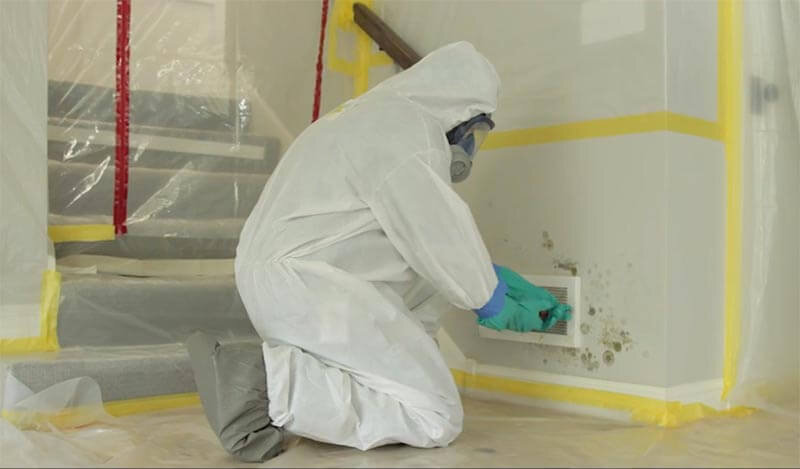Situating Post Remediation Inspection Near Me Services
Wiki Article
Effective Post Mold Removal Solutions for Your Home
Mold growth in homes can be a consistent problem, typically needing a systematic strategy for effective post-remediation solutions. From comprehending the aspects that add to mold and mildew growth to implementing appropriate cleaning strategies and moisture control actions, the process can be detailed yet crucial for keeping a healthy living setting. Post Mold remediation cleaning.Comprehending Mold And Mildew Growth Variables
The key aspect adding to mold development is wetness. Mold and mildew spores need dampness to thrive and germinate, making damp or humid settings highly susceptible to mold infestations.
Furthermore, air movement and light exposure can impact mold growth. Locations that do not have proper air flow and all-natural light are more prone to mold advancement. By dealing with these factors thoroughly, individuals can properly reduce mold and mildew development and secure their living environments.
Appropriate Mold Cleaning Strategies
Making use of efficient cleaning techniques is vital in stopping the reappearance and resolving of mold contamination in indoor environments. When dealing with mold, it is essential to prioritize safety by putting on protective equipment such as safety glasses, masks, and handwear covers. The initial step in appropriate mold cleaning is to have the affected area to stop the spread of spores to uncontaminated areas. This can be accomplished by securing off the space and utilizing air scrubbers or unfavorable air equipments to preserve air top quality.
Implementing Dampness Control Steps
To properly prevent mold development and contamination in interior atmospheres, carrying out wetness control measures is vital. Moisture is the primary aspect that fuels mold and mildew advancement, making it vital to handle humidity degrees within the home. One reliable measure is to utilize dehumidifiers to keep indoor moisture degrees listed below 60%. In addition, ensuring proper ventilation in locations susceptible to moisture buildup, such as kitchens and shower rooms, can help decrease the threat of mold and mildew development. Consistently examining and repairing any leaks in pipes, roof coverings, or windows is also essential in avoiding excess dampness buildup. Using exhaust fans while cooking or showering, and enabling air blood circulation by keeping furnishings a little away from walls can aid in moisture control. Furthermore, using moisture-resistant materials in high-humidity areas, such as mold-resistant drywall and paints, can be beneficial. By faithfully carrying out these wetness control procedures, house owners can successfully lower the likelihood of mold recontamination and keep a healthy indoor environment.Using Natural Removal Solutions
After effectively executing dampness control steps to avoid mold growth in interior atmospheres, property owners can currently check out the efficiency of all-natural remediation services in keeping a healthy and balanced space. All-natural removal remedies utilize eco pleasant approaches to deal with mold and mold, making them a popular selection for those seeking non-toxic choices. One such solution is utilizing vinegar, an all-natural antimicrobial representative, to disinfect and tidy surfaces contaminated by mold. Simply dilute vinegar with water and spray it onto the impacted areas, allowing it to sit for a few hours prior to wiping clean. Furthermore, tea tree oil, recognized for its antifungal residential or commercial properties, can be blended with water and sprayed onto mold-infested surfaces to inhibit more growth. One more natural alternative is hydrogen peroxide, which can properly kill mold and mildew on various surface areas without leaving harmful residues behind. By incorporating these natural removal services right into their cleansing regimens, homeowners can properly fight mold development while promoting a much healthier indoor setting for themselves and their family members.
Maintaining a Mold-Free Atmosphere
On a regular basis evaluating areas susceptible to mold and mildew growth, such as bathrooms, cooking areas, basements, and attics, is vital. Appropriate ventilation in areas with high humidity levels is additionally key to stopping mold development.Additionally, maintaining sanitation in the home is vital for mold avoidance. Keeping interior plants in check and ensuring appropriate drainage in outside landscape design can minimize wetness build-up, reducing the probability of mold infestations.
Final Thought
To conclude, it is necessary to address mold and mildew growth factors, utilize correct cleaning strategies, apply moisture control procedures, use all-natural removal solutions, and keep what to do after mold remediation a mold-free atmosphere in order to successfully take care of article mold and mildew removal in your house - Post remediation mold testing near me. By following these approaches, you can avoid mold and mildew from reoccuring and guarantee a healthy and balanced living atmosphere for you and your household
The key variable contributing to mold development is wetness. Mold spores call for wetness to thrive and sprout, making damp or moist atmospheres very susceptible to mold and mildew infestations.To effectively avoid mold development and contamination in interior atmospheres, carrying out wetness control measures is extremely important. In addition, making certain appropriate ventilation in areas susceptible to moisture build-up, such as washrooms and kitchens, can aid reduce the danger of mold development.After efficiently implementing wetness control actions to stop mold development in interior atmospheres, home owners can currently check out the performance of all-natural remediation options in maintaining a healthy and balanced living room.
Report this wiki page